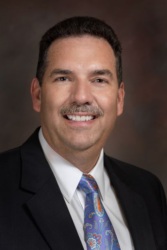When Dr. Scott Muri arrived to lead Ector County schools in 2019, the district was struggling to fill over 350 teacher vacancies districtwide. Using a strategic staffing model, Ector County Independent School District (ECISD) reduced the number of vacant teaching positions to a mere 36—a 90% reduction in only four years.
ECISD sits in west-central Texas. Like everything in Texas, it’s big. In fact, by land mass, it is one of the largest districts in the state at over 900 square miles. Recruiting and retaining teachers was always a challenge in ECISD, with over 40 schools that needed staff. The region is heavily influenced by the oil and gas industry, and district leaders were often competing with these companies (and their deep pockets) for talent. With persistent vacancies, the district needed to think creatively to better attract and cultivate its own talent.
To accomplish this, the district decided to implement Opportunity Culture, a strategic staffing model extending the reach of highly effective teachers through larger class sizes. Given that these larger class sizes violated state restrictions, ECISD sought state designation as a District of Innovation (DOI), which allows districts to waive certain state regulations to implement innovations.
Here is an excerpt from ECISD’s DOI plan, detailing the challenge they are attempting to address and the exemptions necessary to achieve it.
Ector County District of Innovation Plan
25.112 Class Size
Current Challenges:
- Due to staff vacancies and other factors, ECISD submitted a class size waiver request to the Texas Education Agency (TEA) for 204 PK–4th grade classes above the 22:1 ratio.
- Using Opportunity Culture as a strategic staffing model creates classes over the 22:1 ratio by design.
Benefits, Guidelines, and Rationale of Exemption for ECISD:
- Waiving the maximum class size limit will allow ECISD to fully implement the Opportunity Culture strategic staffing model without requesting an exception from TEA in grades PK–4.
- It is not the intent of ECISD to use this portion of the [District of Innovation plan] to increase the student: teacher ratio in every PK–4 classes across the district.
Dr. Muri and his team “started small,” rolling out Opportunity Culture as a pilot program in 10 schools across the district. The model empowers teachers, often referred to as multi-classroom leaders, to lead several classrooms with a team of teachers and support staff who share responsibility for student outcomes.
Starting small also allowed Dr. Muri and his team to address implementation challenges. For example, given this new approach to staffing, the district also had to develop new processes for its human capital department to focus on more intentional talent acquisition and development that would produce teachers who could serve in these critical leadership roles.
Since implementing the model, ECISD has rolled out Opportunity Culture in 13 additional schools with about 100 multi-classroom leaders: “After seeing the success of the pilot, other school leaders and teachers clamored for the model in their own schools, so we expanded the pilot,” said Dr. Muri. “Now even more teacher leaders are exercising their skills and getting paid more for their work.” The model is also keeping good teachers in the classroom: Dr. Muri noted that he interviewed a candidate for an assistant principal role and, though he offered her the job, she chose to remain a multi-classroom leader, citing her appreciation for the leadership opportunities available through the role and the additional stipend. The teacher leader role has become so attractive and rewarding, it is keeping highly effective teachers in the classroom.
As the program has grown, ECISD has continued to track outcomes, contracting with Texas Tech University to study the impact of the new models on teachers and students. In its most recent evaluation, students taught by teachers working under the direction of a multi-classroom leader experienced stronger achievement in both reading and math, with even larger gains for English-language learners.
Dr. Muri says people often ask if the model costs more. While the district provided some funds to support the redesign of the staffing model, along with technical assistance as the schools transitioned, the program does not cost the district more once implemented. To keep the program cost neutral, principals use existing allocated funds in two ways: They pay highly effective teacher leaders more to take on more students, and they hire additional staff to support larger classes.
“We are really proud of the work we have done to decrease teacher vacancies and more importantly provide our students with better instruction and improved student outcomes,” said Dr. Muri.


